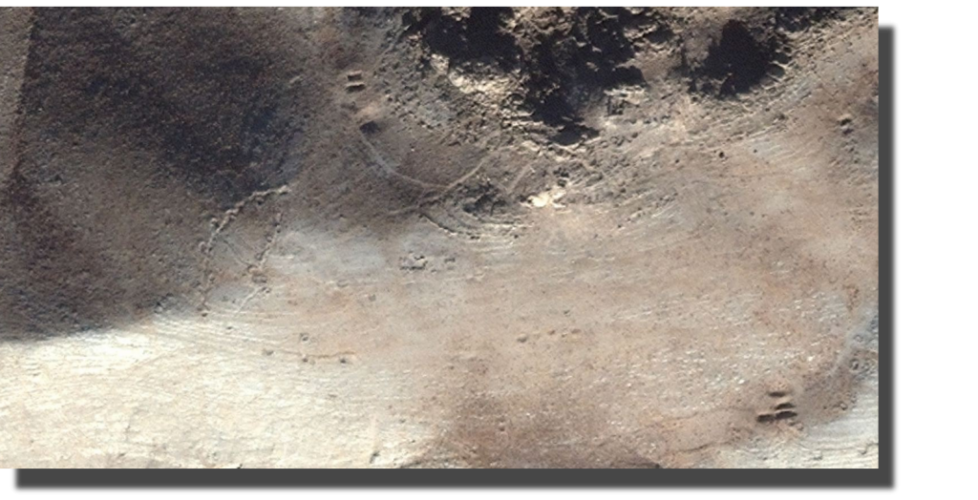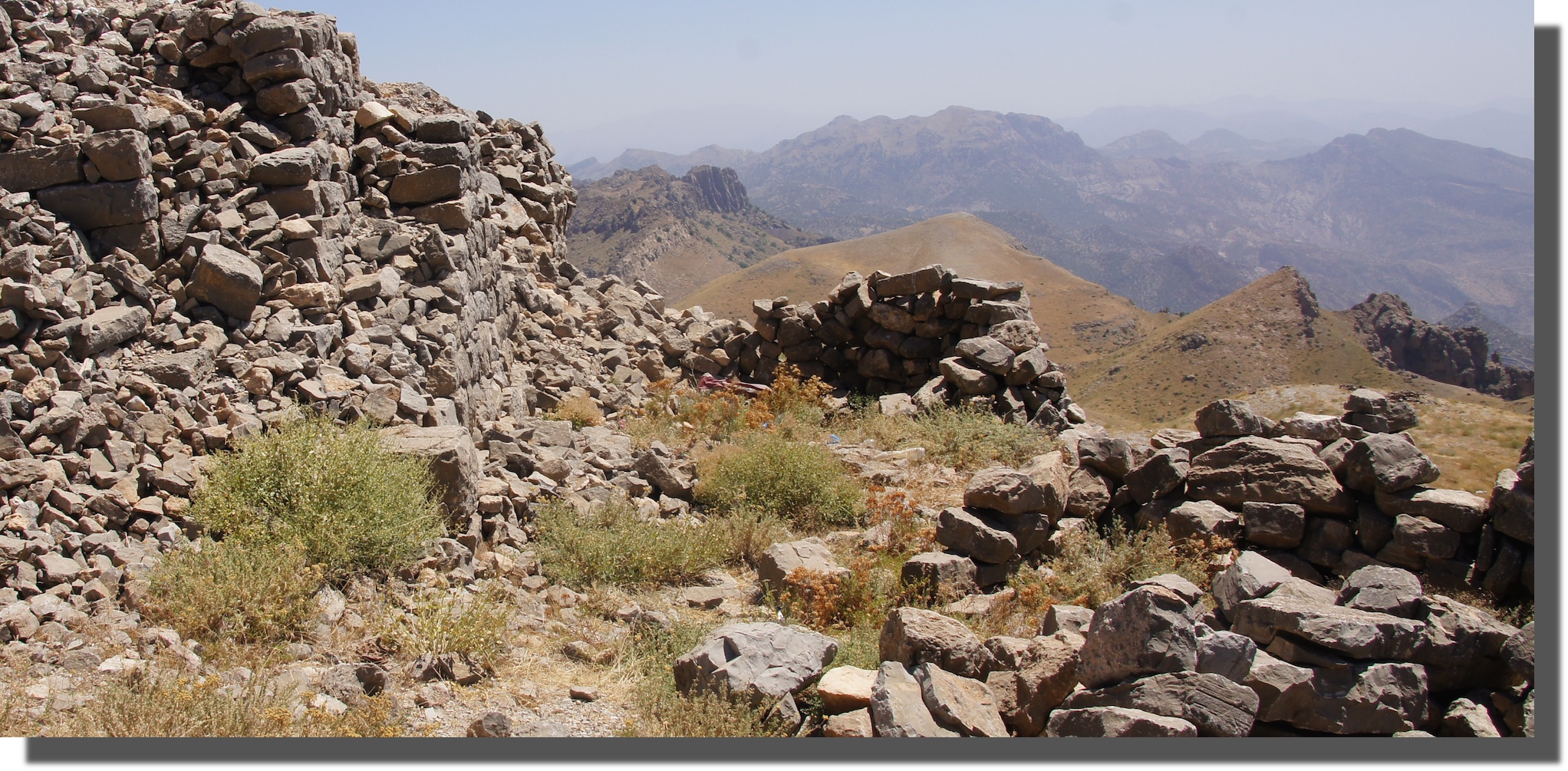The Ark atop Mt. Cudi
This is a satellite view of the summit of Mt. Cudi. Notice the roughly ship-shaped formation on the left (west) side of the summit (satellite photo courtesy of Bing Maps):
In ancient times, there were numerous pilgrimages to the top of this mountain to view what was said to be Noah’s Ark. However, with the exception of satellites, this artifact had never been photographed. I climbed the mountain for a closer look. Up close, the main line of that feature is just heaped up stones:
Circular depressions with larger stones atop them were distributed along the main line. These can also be seen in the satellite view above.
I wondered if this could be the remains of a building. However, unlike the other ruins here and elsewhere on the mountain and its foothills, the apparent wall was just loose heaped up gravel. The circles along the line reminded me somewhat of those along the city wall of Thamanin, which I had discovered in the foothills (the subject of my next blog post). However, those were regularly spaced along the wall, possibly the remains of guard towers. These looked completely random. (A close look at the satellite photography will confirm this.) And as I looked more closely, I noticed something about the order in which things had been done. The gravel-like stones had been heaped up first. Only later had someone stacked the larger stones around the perimeter of the circles, placing them on top of the heaped gravel. They were not original walls.
I noticed that elsewhere around the summit, the stones from crumbling but once well-built ancient walls had been harvested and stacked in crude semi-circles. These were not especially sturdy or durable, so I suspect that they had not been standing very long. Since the mountain has been occupied by guerrilla fighters for the past several decades, this was likely an attempt to form fortifications from the ancient shrines. Plowshares into swords. I suspect that the existing holes in the ship-like structure were likewise reinforced with stones from the old walls to make what look like machine gun nests. I found some shell casings near the summit, which seem consistent with this theory.
Thousands of years of historical accounts tell of people ascending Mt. Cudi to dig up pieces of wood covered in tar from Noah’s Ark (or its equivalent in their various great flood traditions). The Babylonian priest Berosus records pilgrimages to take souvenirs of the ship of their flood hero. The Assyrian king Sennacherib is said to have made an idol of the wood in 699 BC, promised to sacrifice his sons to said deity if he had military success, and then been bludgeoned to death with that very idol when his sons got word of the oath. In 537 AD, the Byzantine Emperor Justinian is said to have had the wood for the doors of the Hagia Sophia Cathedral brought from here. And with the rise of Islam, Umar ibn Al-Khattāb was said to have taken what remained and built a mosque from them. Since then, there have been additional claims of people digging up tar covered bits of wood.
For example, J. J. Benajmin II, who visited the mountain in the late 1840s (but did not summit), describes an annual Kurdish pilgrimage (since discontinued): “On descending the mountain they bring with them some remains of the Ark, which, according to their assertion, is still deeply buried in the earth. The little pieces received are in the form of planks; some whitish grey; some black and pierced with holes… I myself obtained several fragments of the Ark which appeared to be covered with a kind of substance resembling tar.”
I suspect that this spot is where pilgrims dug for buried wood. As they dug down (on the left side of the line of gravel seen in the first pic), they heaped up earth toward the outside of the ship-shaped line. Being exposed to the elements for centuries, most of the dirt washed away in rains leaving the stone content of this rocky soil in rain-washed heaps in a line all along the perimeter of their excavations. Every now and again someone attempted a very deep hole. These naturally took the form of circles randomly distributed along the perimeter line. (Sometimes missing the mark as the mountaintop used to be covered by snow much of the year.) Later these holes (partially filled in by erosion) were repurposed by the PKK guerrilla fighters.





May 13, 2014 @ 11:21 pm
Wow! I didn’t even know that a place like this even existed! In what country does this place exist? Is it habitable? Since people made pilmagrimages here, does that mean that this place was holy?
If so, is it still, or is this place now used for warfare? Is it safe for people to still visit?
May 15, 2014 @ 8:56 pm
Awesome stuff !!!! Sounds very exciting. Take care of yourself
May 15, 2014 @ 9:12 pm
Fascinating ! That’s very cool. I’m following your posts closely.
June 4, 2014 @ 9:28 pm
This is an absolutely fascinating blog post, you had me wanting to know more every sentence I read. I am not Christian and doubt there was an Ark as the one in the Bible on top of here and yet plenty of the bible has historical events that are accurate, just slightly twisted to an agenda by the writer. That leaves me with the questions such as “How much has the landscape changed that a ship is on top of a mountain, indeed, was it a ship?” and also,”If it wasn’t a ship, what was it?!”.
June 12, 2014 @ 10:13 pm
The history of this place is just breathtaking! People seem to be entranced by the whole Noah’s Ark story and I’m curious how humanity will react when and if it will be found; I find it unbelievable that king Sennacherib could sacrifice his sons for the idol. These pictures look like screenshots from a documentary, great work!